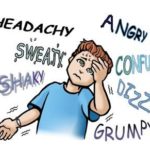People often ask us what they can do to hold their adjustments better. That’s an important question that involves many facets of a person’s lifestyle.
Based on other health care experiences, people are often expecting a singular answer, to this multi-faceted question. For example, a person in pain is given a pain drug, stretching exercises are recommended for someone who is stiff, and a deep cut gets stitched up. While each of those might be the correct therapy, in actuality, people’s lives are far more complex than that.
When a person with an upper neck subluxation asks what they can do help reconstruct the damage done by long term subluxation, they’re expecting that perhaps a particular chemical, exercise, or nutrient can be applied to change something in their upper neck. In our culture we’ve come to think  that way, relying on a quick-fix mentality, which can itself be a part of the problem. So often we find that people seek our care after having carried years of nerve interference without symptoms. Then when symptoms suddenly appear, they’ll tend to look for a remedy to address what is perceived to be a short-term problem. Now I can just about feel some readers frustration when they sense that this discussion isn’t about another quick-fix. But here’s the thing, few people ever come to us first. Usually they’ve tried a few things on their own first. Then when that fails to resolve the issue they’ll go where they have the most faith, their family doctor. Having been to their physician, having rode the frustrating merry-go-round of referrals for this and that, and all to no avail, that’s when someone says “you should try my chiropractor.”
that way, relying on a quick-fix mentality, which can itself be a part of the problem. So often we find that people seek our care after having carried years of nerve interference without symptoms. Then when symptoms suddenly appear, they’ll tend to look for a remedy to address what is perceived to be a short-term problem. Now I can just about feel some readers frustration when they sense that this discussion isn’t about another quick-fix. But here’s the thing, few people ever come to us first. Usually they’ve tried a few things on their own first. Then when that fails to resolve the issue they’ll go where they have the most faith, their family doctor. Having been to their physician, having rode the frustrating merry-go-round of referrals for this and that, and all to no avail, that’s when someone says “you should try my chiropractor.”
Since our work is directed at improving function, rather than just changing symptoms,  it addresses underlying issues, which have often been there for years. In the example of the person with a problem in the upper neck, we know that the person’s entire body is affected by that subluxation. Of course the most important step is to clear the nerve interference with a precise adjustment, but undoing years of damage involves complex changes within the body that are necessary for reconstruction to happen.
it addresses underlying issues, which have often been there for years. In the example of the person with a problem in the upper neck, we know that the person’s entire body is affected by that subluxation. Of course the most important step is to clear the nerve interference with a precise adjustment, but undoing years of damage involves complex changes within the body that are necessary for reconstruction to happen.
Thankfully the wisdom within the body is able to do a lot once the interference is out of the way. So the first step is to eliminate the interference and the next step is to keep it clear. That’s why we monitor a person’s spine. After that everything else matters.  The food we eat, the nutrition we supplement, the amount of rest our body gets, the exercise we give it, our hygiene, pure water, clean air, a positive attitude, reducing stress, giving our body time to heal and keeping our chiropractic appointments, adopting healthy habits, attention to spiritual matters, less chemical exposure, and so on. Yes it all matters, so to get optimum results we need to take care of our whole body, not just the ailing part. By committing to improving the whole body, we set the stage for problem areas to heal. The whole body needs good fuel, the entire body needs exercise, not just the place that hurts.
The food we eat, the nutrition we supplement, the amount of rest our body gets, the exercise we give it, our hygiene, pure water, clean air, a positive attitude, reducing stress, giving our body time to heal and keeping our chiropractic appointments, adopting healthy habits, attention to spiritual matters, less chemical exposure, and so on. Yes it all matters, so to get optimum results we need to take care of our whole body, not just the ailing part. By committing to improving the whole body, we set the stage for problem areas to heal. The whole body needs good fuel, the entire body needs exercise, not just the place that hurts.
One of the most important parts of answering this question involves a focus on the future. While working to undo the damage of prolonged vertebral subluxations in adults, we shouldn’t overlook the importance of teaching our children to get their spines checked regularly.  It gives them a step up on life, better performance in their school work, play and activities, as well as a lasting legacy of good healthful living to pass on to the next generation.
It gives them a step up on life, better performance in their school work, play and activities, as well as a lasting legacy of good healthful living to pass on to the next generation.
